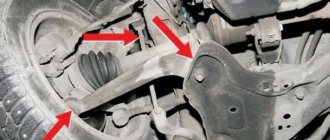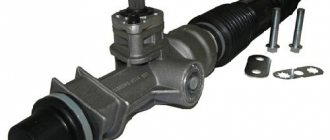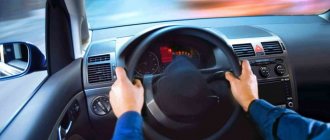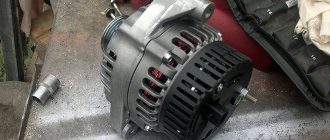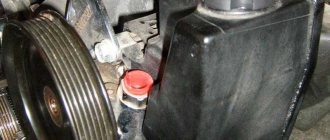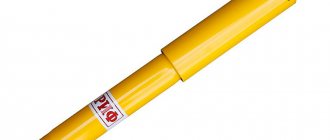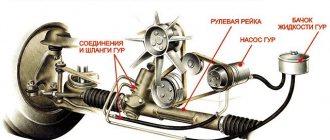Normal operation of the steering system should not be accompanied by extraneous sounds, such as knocking or clicking noises when turning the steering wheel. The appearance of such symptoms indicates the likelihood of wear of components of one of the most important active safety systems of the car, or other components of the chassis that are driven along with the rotation of the steering wheel.
Possible causes of extraneous sounds when turning the steering wheel:
- wear of the steering rack drive shaft cardan crosspieces
- play in the splined connection of the rack drive shaft
- wear of the steering rack supports
- biting the steering rack rod
- radial play of the steering column shaft
- moisture ingress and corrosion of the lower ball joint
- wheel drive grenade malfunction
- violation of the integrity of the spring
Wear of crosspieces of cardan joints of rack drive shaft
If you hear clicks when turning the steering wheel, which can also be felt on the steering wheel, you should check the condition of the steering drive elements. The wear of the crosspieces is detected by probing the universal joint when turning the steering wheel to the right and left at a small angle.
The bite is clearly felt by the hand and allows you to accurately identify the worn part. It is necessary to take into account that there are several such parts and some may be located in hard-to-reach places. In some cases, it may be necessary to dismantle components to disassemble and inspect components, followed by replacement of the faulty part.
The plastic protection is loose
If, when turning the steering wheel sharply, the knock sounds like plastic rubbing, almost 100% everything is fine with the car. As a rule, such sounds are produced by poorly fitted fender protection. When turning the front wheels, very often we touch and slightly deform the plastic locker. It is he who makes such unpleasant, but quite safe sounds.
However, you should not ignore this completely. The fact is that the plastic protection is attached directly to the “skirt” of the front bumper. And if it becomes completely deformed, it is possible that one fine day, when you make the next turn, you will simply tear it out (and in the process damage the bumper). Therefore, it is better not to hope for “maybe”, but to adjust the defense.
Play in spline joints
Play in the splined connections of the rack drive shaft is detected in a similar way. In some cases, the so-called “bleeding” of the shaft can help. To do this, you need to loosen the fastening bolt and move the shaft several times along the splines, then tighten it again. There is a possibility that the splines, as a result of wear, have lost effective engagement and, as a result of such a procedure, will come into more intimate contact, and the free play in the connection will be eliminated for some period of time. If bleeding does not help, change the spline shaft.
Worn steering rack supports
During the operation of the car, not only the steering rack mechanism, which takes up the load with each turn of the wheels, wears out, but also the rubber fasteners, through which the unit is fixed to the body or subframe, are subject to wear, destruction and loss of elastic properties. In this case, when you turn the steering wheel in place, you will feel characteristic knocks or clicks, indicating that the rack body is moving freely. The larger it is, the stronger the sound will be under load. Wear is detected by monitoring the position of the unit when the steering wheel is turned left and right. At the same time, the movement of her body will be clearly noticeable. The solution is to either seal the clamps by placing a layer of rubber under them, or immediately replace worn-out rubber bands with new ones.
A foreign brand does not guarantee the absence of breakdowns
The situations described above are typical not only for Russian cars. In principle, an expensive foreign car is not immune from this. The whole question is how often this will happen.
As already noted, the quality of cars produced in Russia has improved significantly. This applies to both truly Russian VAZs and cars produced here under license. The percentage of factory defects has been significantly reduced: a knock when turning the steering wheel (Logan, for example, is assembled in Russia) will not appear immediately. And it is quite possible to avoid such situations. Experts advise undergoing the necessary diagnostics at specialized service stations every six months, without leading to the notorious “knocks and crackles” in the chassis.
In addition, given that the road surface is not always of high quality, it is necessary to observe the speed limit and take safety measures when crossing difficult or simply bad areas. If these simple recommendations are followed, your car will serve you for many years without any breakdowns, and the money not spent on vehicle repairs can be used for something else.
Biting the steering rack rod
Biting the steering wheel when rotating indicates damage to the rod due to corrosion as a result of moisture getting inside the body. Typically, biting appears when the steering wheel is turned to a certain angle or number of revolutions. When a rusty section of the rod passes through the plastic guide bushing, strong friction occurs, since the surface of the rod is no longer mirror-smooth, but rough. This is accompanied by a characteristic creaking or clicking sound when turning the steering wheel. The unit must be disassembled and inspected for parts damaged by corrosion, followed by their replacement. In advanced cases, the entire rack will need to be replaced.
When to replace parts
The situation is much more serious if the knocking sound when turning the steering wheel is more like a metallic crackling or grinding sound. This means that in the near future you will face significant financial expenses. And in order to reduce them, you need to understand the reasons yourself.
When a “gurgling” knock appears when turning the steering wheel, the simplest explanation for this is wear on the tie rod ends. A rather unpleasant phenomenon that requires attention. After all, if the wear process continues, the entire steering mechanism may fail, and as a result - expensive repairs, and maybe even an emergency on the road. The repair is not very expensive, although the tips are usually replaced in pairs - on both sides of the car. The main difficulty lies in subsequent work on wheel alignment.
Another fairly common problem, when a knock appears when turning the steering wheel (Kalina or Priora are susceptible to this “sore”), is associated with wear of the bearing of the upper support of the shock absorber strut. The disease is unpleasant, but quite easily eliminated. The bearing itself is not very expensive, and replacing it will not take much time.
Steering column shaft play
Clicks in the steering column usually appear while the car is moving and indicate the presence of radial play in the shaft as a result of bearing wear. Backlash is diagnosed simply - just reach the shaft with your hand and try to swing it relative to the axis of rotation. If a malfunction is confirmed, repair of the steering column is possible on some cars; on other models, only replacement of the entire assembly is possible.
The malfunction is not critical and, apart from an unpleasant knock, will not cause any other consequences for some time.
Universal diagnostic method
Diagnosis of a malfunction of the internal CV joint
We present to you an algorithm for another, universal option, how to find out which “grenade” is crunchy. You need to act in the following sequence:
- Place the car wheels level.
- Raise one of the front wheels using a jack.
- Put the car on the handbrake and neutral gear.
- Start the engine, depress the clutch, engage first gear and slowly release the clutch, that is, “move off” (as a result, the suspended wheel will begin to rotate).
- Slowly press the brake pedal, creating a natural load on the joint. If one of the internal “grenades” is faulty, then at this time you will hear familiar knocking sounds on the left or right side. If the internal CV joints are in order, then the car will simply start to stall.
- Turn the steering wheel all the way to the left. Slowly press the brake pedal. If the internal “grenade” is faulty, it will continue to knock. If the outer left CV joint is also faulty, then sound will also be added from it.
- Turn the steering wheel all the way to the right. Carry out similar procedures. If a knocking noise occurs when the steering wheel is turned to the right, it means that the right outer joint is faulty.
- Be sure to put the gear in neutral, turn off the engine, and wait until the wheel comes to a complete stop before lowering it to the ground.
Corrosion damage to the lower ball joint
A rusty lower ball joint, which bears a significant load, can produce characteristic clicks and a fairly loud squeak when turning. The reason is mechanical damage to the boot and moisture ingress, which leads to leaching of the lubricant. In addition to the creaking, there is usually already some play in the connection, formed as a result of friction of the rusty ball against the plastic seal. As a result of the play, a clearly audible knocking sound occurs when driving over uneven surfaces. A ball joint damaged by corrosion must be replaced.
Subframe (atypical situations)
Sometimes atypical situations that are quite difficult to diagnose lead to knocking when turning. For example, there is a known case when, while the car was moving, a small stone hit the subframe and got stuck there. When you turn the steering wheel in one direction or the other, a natural displacement of the steering gear elements occurs, and they seem to run over this stone. When the elements were restored to their original position, they jumped off the stone, making a characteristic sound. The problem was solved by removing the stone.
When repairing suspension elements, for example, when replacing the front arm, the latter may touch the subframe when turning the wheel. Naturally, this is accompanied by a blow and a grinding sound. To get rid of it, it was enough to lift the subframe using a pry bar.
Another atypical situation of knocking in the suspension when turning is that the subframe bolt loosens, and the subframe itself can knock when driving, and even more so when turning. It can be eliminated by tightening the corresponding bolt.
Broken strut spring
Often the cause of extraneous sounds is a spring that has burst as a result of metal fatigue. A failed spring can be easily identified by inspection. The elastic suspension element should be replaced in pairs with the opposite one to avoid body distortion. A broken coil can touch the body or other parts, producing grinding and clicking noises when turning the steering wheel.
Many drivers quite often encounter such a problem that when turning the steering wheel, clicks or knocks are heard. This situation can occur in both old and new cars; it is quite common. Any driver can determine the source of these clicks without contacting a service station. This saves time and money. If the car owner has at least some repair skills, then he can fix the problem himself, spending only on new spare parts.
Domestic does not mean bad
It's no secret that today the most popular cars are the so-called consumer class. A fairly large segment of sales in this sector is occupied by the domestic auto industry. As a rule, a consumer who buys such a car is guided by the manufacturer’s affordable pricing policy while the quality has increased almost to world standards. And that’s why we see more and more brand new Ladas on our streets, in which we no longer even recognize features familiar from childhood.
The new Grands, Priors and Kalinas embody almost all modern innovations available for cars of such a modest class. However, are they reliable? The latest generation of VAZs, the famous “eights”, “nines” and “tens”, quite often lost even to old-style foreign cars in reliability and adaptability to our roads. They were still bought because of their modest price, but they were still viewed more as a temporary component of their life, hoping in the near future to switch to more comfortable and reliable cars of Western or Asian production.
As already noted, most often in modern road realities, a car breaks down. Is it reliable in modern VAZs? The answer is clear: yes. Engineers and designers have tried to make life easier for the modern driver.
Causes of clicking noises when turning the steering wheel
If the steering wheel clicks when turning, and this sound is heard with every maneuver performed, then first you need to determine the nature of the sound. If the sound is clear and ringing, then this indicates the presence of a metal-to-metal impact. If the sound is less clear, muffled, then this is more likely a contact of metal and plastic. In addition, it is necessary to determine at least the approximate location where the sound comes from. This will not only reduce the troubleshooting area, but will also help to at least approximately determine the breakdown.
The simplest cause of clicking noises in the steering wheel is incorrect tire pressure. If they are too different from each other, clicks may appear in the steering column when turning the steering wheel. In addition, the cause may be torn off fender liners.
If you hear clicks in the steering wheel, check the pressure in the wheels and the condition of the fender liners.
If the screws have been torn out, then the torn fender liner will cling to the tire and dangle, making clicking noises when turning the steering wheel left and right.
These breakdowns can be quickly and easily fixed: properly inflate the wheels and screw on the wheel arch liners.
However, there are more serious reasons for knocking in the steering wheel. For example, a malfunction of the steering mechanism is quite dangerous, then clicks are heard directly in it. You can also check the car yourself by arriving at the overpass and carefully examining the suspension.
Checking the condition of the car suspension
Steering rod silent blocks can also cause clicking noises. Wear of silent blocks and delamination of rubber can even produce clicks when turning the steering wheel in place and while driving. If this is the cause of the knocking, then the silent blocks must be replaced.
If the steering wheel clicks when turning, check the tie rod ends and tie rods.
The cause of clicking noises when turning may be a faulty CV joint.
If clicks when turning are heard along with the characteristic hum of the wheels, then the problem lies in the wheel bearing. One of the most dangerous malfunctions, it is better to immediately replace the bearings, and if the driver is forced to drive such a car, then the speed should not exceed 80 km/h.
Common causes of knocking noise associated with the steering mechanism
Now let's look at typical problems and how to fix them.
The first thing you need to do is check the pressure in the wheels, because the difference in tire inflation may be the cause of the knocking.
Then check the fastening of the plastic protective fender liners. It is quite possible that the screws that secure them to the body have broken out, causing the fender liner to come off and cling to the wheel, making a knocking sound when turning.
In general, such a malfunction is very easy to fix; all you need to do is secure the torn fender liner with new screws.
The most dangerous from a safety point of view is the appearance of a knock in the steering mechanism itself. To check the condition of the mechanism, you will need to drive the car onto an overpass.
The first thing you need to check is the steering ends. Damage to the tip boot leads to sand getting inside it, which intensively wears out the surfaces of this element, causing play to appear in the tip, which is the source of knocking.
You can check the condition of the ends by loosening the tie rod with a pry bar.
Strong play and knocking will indicate wear on the tip and the need to replace it.
Steering ends for domestic cars are relatively inexpensive, and you can purchase them at almost any auto store.
Replacing them is also easy. It is recommended to replace both tips at once.
The complexity of performing this work comes down to the need to use a special puller.
After replacing the tips, you will still have to contact a service station to set the wheel alignment angles.
A knock may also appear in the steering rod silent blocks. They are located in the place where these rods are attached to the steering rack.
Delamination of the rubber of these silent blocks can also lead to knocking, although it will appear not only when turning, but constantly while driving.
This steering mechanism malfunction, although very rare, is still possible. It can be eliminated by removing the steering rods and pressing in new silent blocks.
A knock may also appear in the steering mechanism itself. It usually forms after the rack guide bushings wear out, causing a gap to appear between the rack and gear.
In some cases, everything can be eliminated by removing the gap with the mechanism's adjusting bolt.
Additional symptoms
Causes of clicks in the steering column
As we see, there can be many reasons for clicks in the steering wheel. Suspicious symptoms may include the hum of wheels, tapping, ringing, crackling, etc. In addition, it is always necessary to monitor the behavior of the car itself. If there is one breakdown or another, the car will not behave as usual on the road. If the tip or bushing breaks, the car may “wobble” while driving. If the CV joint is faulty, the clicking will increase over time to an unpleasant grinding sound. The car will always show what is wrong with it.
Self-diagnosis: easy to master
This, of course, does not happen immediately, but with the acquisition of experience, a person with a minimal inclination towards technology can easily identify a number of standard breakdowns of his car. To some extent, the skill of self-diagnosis is also due to the high cost of maintenance, and sometimes to the incompetence of specialized personnel at the service station.
Typically, the ability to correctly identify car breakdowns will be useful to you in any case, regardless of the chosen car brand. First of all, it suffers - most often due to bad roads. We will try to understand the reasons for the rapid wear of the chassis of today's popular brands. We will describe possible options for their breakdowns, learn how to diagnose them based on symptoms (a knock in the steering wheel when turning, for example), and also consider options for quick and preventive maintenance of your “iron horses.”
Ways to eliminate clicks in the steering wheel
Car enthusiasts often wonder why clicks are heard when turning the steering wheel while driving. This is a fairly common problem. This mainly applies to cars with a steering rack. Many drivers simply do not pay attention to this problem. Which in many cases leads to serious problems with the steering rack. Therefore, when symptoms appear, it is necessary to diagnose as quickly as possible and eliminate the malfunction. So far it has not led to more expensive repairs. To diagnose, you just need to determine the place where the clicks are coming from. Then carry out repair work. Why do you hear clicks when you turn the steering wheel while driving? Let's start with perhaps the most harmless reason. On almost all cars, the turn signal switch is located on the steering wheel. These controls have a ring in their design that is designed to turn off the repeaters after the maneuver is completed. This ring can sometimes click when turning the steering wheel without the turn signal on. These clicking sounds are normal. That is, if you hear clicks only near the steering wheel, you can ignore them.
There are two reasons:
- Sometimes this problem occurs due to different tire pressures.
The peculiarities of domestic roads often lead to damage to steering rods. Usually they bend. In this case, the car is observed to be pulled to one side when moving in a straight line. Tire wear also accelerates (eats rubber). Diagnosis is made visually. If a spare part is noticeably different from the norm, it should be replaced. The lever cannot be aligned. All the same, the deformed part will not be able to fully perform its functions.
The hydraulic booster deserves special attention. Problems also occur with this design element. Sometimes he starts howling. This indicates the need to tighten or replace the drive belt. If, when you start to turn, you feel a slight push in the steering wheel, then you should check the fluid level in the amplifier reservoir and add it. Conclusion
. All drivers know that the steering mechanism is extremely important for safe driving. Therefore, any sign of malfunction scares people. In this case, they begin to ask the question why clicks are heard when turning the steering wheel while driving. In fact, there may be several reasons for this. One of them is quite harmless and is explained by design features, the other can lead to expensive repairs. And it is recommended to eliminate it as quickly as possible.
The good condition of the steering system is the key to safe maneuvers on the road. Excessive play in the vehicle's front axle control mechanisms is unacceptable. They cause a slow response to sharp turns of the steering wheel, which is unacceptable in emergency situations. Driving a car with problems in the main unit that sets the motion vector is prohibited both for ideological reasons and in accordance with traffic rules.
Causes related to drive and suspension
Now let's move on to other elements of the car in which knocking may occur when turning the steering wheel. There are not many of them, but malfunctions with them can lead to expensive repairs
If you hear a knocking sound with a crunching effect when the wheel is turned completely, this often indicates severe wear of the constant velocity joint (CV joint) used in the wheel drive mechanism.
The CV joint itself is a fairly reliable element if it is protected from dust and dirt getting inside. Read on the topic - replacing the inner CV joint boot of popular car models.
Therefore, it is quite easy to determine that this is the cause of the knocking when turning - you need to carefully inspect the protective boot.
If it is damaged, we can say with complete confidence that the cause of the third-party crunch is the CV joint.
Many car enthusiasts claim that it is possible to fully restore the performance of the CV joint by removing it, washing it and adding new lubricant.
Some additionally add small shavings of soft plastic to the lubricant, for example, from a cork from a Champagne bottle. Be sure to replace the damaged boot.
However, such measures can only delay the replacement of the hinge for a while and in the end it will still have to be replaced. And when to perform this operation - immediately upon detection of damage to the boot, or a little later - it is up to the car enthusiast to decide.
In many modern domestic cars, the weak point is the shock absorber strut bearing. It can also cause knocking.
This problem seems to be easily solved - it is enough to replace the support, but sometimes this is not very easy to do. After all, you will have to remove the entire rack from the car.
Also, a broken strut spring may be knocking in the suspension. At the same time, it will no longer be able to fully perform its functions, which will lead to rapid failure of the shock absorber.
Therefore, if noise appears, you should immediately inspect the spring. If it bursts, you will have to change it, and it is changed in pairs on both sides of the car.
If you hear a knocking sound on your car when turning, but it is also accompanied by a hum, it is likely that all this is due to wear on the wheel bearing.
It is quite easy to diagnose his condition.
You need to jack up the wheel on the side where the knock is coming from and rock it, checking for axial play.
If such play exists, the bearing needs to be replaced, which is impossible to do without the appropriate equipment and knowledge.
If you hear a noticeable knocking noise when you move the steering wheel left to right: diagnosis
There is no need to make efforts to find out the degree of permissibility of play in the “steering” of a modern car. The critical state of the system is always accompanied by tapping sounds. This corresponds to the limit when the gaps of the rubbing pairs are within unacceptable limits. The car must be promptly delivered to a technical service point or repaired independently. Otherwise, it will eat rubber on the front, albeit in small quantities.
Probable Causes
If an audible knocking sound in the front suspension when turning the steering wheel indicates wear in its constituent parts, then an extraneous clicking sound when the steering wheel rocks requires inspection of other structural elements. As a rule, the problem lies in the vehicle control system.
Statistics show that there is something to knock in the “steering wheel”. Any pairing may come under suspicion:
- Gap in the fit between the steering tip and the strut.
- Excessive play in the steering rack.
- There is a problem with the steering shaft driveshaft.
- Free movement of the steering wheel on the shaft.
- Gap in steering rod joints.
These parts are present in the design of any car. Knowing the location of all the landings, it remains to identify the defective pair.
For your information. Some old foreign cars have a folding steering column assembly, which breaks under the influence of a critical load that occurs during an accident. He can knock too.
How to identify knocking: expert methods
The classic approach to identifying a faulty unit will be explained in any garage. Its essence is trivial: just ask the assistant to shake the steering wheel and at this time put his hand on the mentioned connections.
Steering rack
However, in some situations this technology loses its relevance. In particular, it will not be possible to identify a defect in the mechanism using this method. To identify a problem in the gear-rack engagement, it is necessary to carry out the following experiment:
- If there is power steering (hydraulic booster): a knocking sound appears when the steering wheel is rotated on a car with the engine turned off, but when the engine is running, there is no knocking at the place.
- There is no power steering: drive along a road section with a changeable direction - when you swing the steering wheel left to right, a knock is heard, but when turning, the rack does not knock due to the small wear of the working surfaces of the gearing in the extreme positions.
For your information. It is not recommended to tighten a worn rack. One of the owners of Hyundai Solaris performed this procedure and after 10,000-12,000 km the steering wheel began to bite. An autopsy showed that the mechanism was beyond repair.
Emergency system
It is also possible to determine experimentally whether the steering column folding assembly is the cause of the knocking. It is enough to swing the “steering wheel” to the sides, while simultaneously pressing it to the bottom. The sound disappeared - the problem is in the emergency system.
How to repair a CV joint
Damage to the internal parts of the hinge most often leads to a complete replacement of the mechanism. However, this only happens with significant wear. In most cases, it is recommended to simply replace the CV joint grease and boot. This is often enough to get rid of the annoying sound and make it easier for the parts to interact.
Therefore, if knocking or clicking sounds appear on one of the four CV joints (we will assume that you have already found out which one), you must perform the following steps:
New inner CV joint
- Drive the car into the inspection pit in order to check the integrity of the boots and the presence of lubricant splashes from under them on nearby surfaces.
- If traces of grease are visible on the boot or other parts, it is necessary to remove the CV joint. Next, disassemble it, remove the boot, wash the internal parts and surfaces, change the lubricant and boot.
- If during the inspection process you find significant play and/or damage to the working surfaces of the parts, you can try to polish them. However, as practice shows, this procedure is ineffective, since you cannot eliminate significant waste with anything. Therefore, the best recommendation would be to completely replace the CV joint.
You can replace the lubricant and boot yourself, as the procedure is simple. The main thing is, when disassembling, do not forget to wash all internal parts and surfaces with gasoline, thinner or other cleaning liquid. And only then apply new lubricant. However, if you are dismantling and replacing the lubricant for the first time, then it is better to have a more experienced car owner or technician with you. Or have him perform the procedure and show you its algorithm. In the future, you can easily cope with such work.
Conclusion
Constant velocity joints are reliable and durable mechanisms. However, during operation, it is necessary to constantly monitor their condition in order to determine in time which CV joint is crunching or making other unpleasant sounds. After all, this indicates a malfunction in its operation. Hinge failure at the initial stage is not critical. You can drive hundreds or even a thousand kilometers with a crunch. However, you should remember that the sooner you repair or replace the CV joint, the cheaper it will cost you. In addition, do not forget about safety. Do not bring the condition of the hinge to a critical level, as this may result in a serious emergency situation, especially at high speed. We hope that the above information helped you figure out what to do when the CV joint crunches and accurately determine which one is faulty.
What causes a knocking sound in the front suspension of a car when turning the steering wheel while driving?
The chassis and steering mechanism are tightly coupled and perform a single function. One rack command is not enough to turn the wheels in one direction. The racks, which are connected by tips and rods to the rack and pinion assembly, must not only absorb shock, but also rotate around their own axis. This became possible with the introduction of movable mounts.
What's causing the knocking?
When there is a knocking sound when turning the steering wheel while driving, but no extraneous sounds are observed in place, we can firmly state that there are problems with the suspension. Its design includes a sufficient number of connections that use bearings. Any support gradually fails, as evidenced by increased play.
A critical gap may appear in the following components of the suspension part:
- Strut support bearing.
- Spherical bearing.
- Wheel bearing.
How to identify tapping
You can calculate the knock in the front suspension of a car when turning the steering wheel experimentally. The work is carried out both on site and while moving - it all depends on the location of the defective area:
- The support bearing is checked by rocking the body to the sides: the hand lying on the “support” holder should not feel any play. The second diagnostic method: grab the front wheel spring and ask an assistant to rock the steering wheel to the sides - there should be no knocking.
- A metallic clatter will be heard in the worn out “ball” when bent with a pry bar.
- The hub support makes a dull knock when turning the steering wheel at small angles at a speed of 50-60 km/h.
For information
Often tapping occurs due to worn silent blocks. There are cases when the occurrence of a metallic sound is associated with the loosening of the nut securing the CV joints to the hubs. The hinge itself cannot knock - it is only capable of making a knock. A wheel spun with a small torque also interferes with acoustic comfort.
Inexperienced owners may confuse the symptoms of a steering malfunction with vibrations in the steering wheel when the car is braking. However, there the nature of the problem is completely different. Strong shocks in the steering wheel can be caused by poor-quality tires or imbalance in the wheel.
Preventing knocking noises
All of the above problems can arise not only with domestic cars, but also with expensive foreign cars. And the difference between these cars comes down only to the time after which the malfunction appears.
Naturally, a foreign car will pass more without a malfunction than the same Priora. But repairing a foreign car, if, for example, its CV joint has failed, will cost much more.
In most cases, knocking noises are caused by inadequate road surfaces. Moving over bumps and holes leads to the fact that all fasteners begin to weaken, hence the appearance of backlash.
To prevent knocking noises when turning the steering wheel, periodic inspection of all elements is required. Moreover, this will require very little, and you can do everything yourself.
The car is placed on an inspection hole or overpass, after which, while under it, you should carefully inspect all the elements, check the tightness of all fasteners with wrenches, tighten the nuts and bolts if necessary, swing the levers with a pry bar, checking for play.
If you do all this periodically, you can avoid the occurrence of knocking noises, or at least increase the life of the car before they occur.
Also, when traveling, you need to adhere to the speed limit, and go through difficult sections at low speed in order to slightly reduce the load on the elements of the suspension steering mechanism.
And if in front of you unexpectedly there are depressions in the road surface, then slow down the car (the car will seem to nose down), and immediately before the problem section of the road, release the brake pedal.
The front of the car will rise, thereby unloading the front suspension, and the car will coast over uneven roads without much damage to the chassis.
Quick Guide
The main reason for tapping is the formation of a gap in the joints. In the steering system, there may be knocking on the tips, ball joints of the rods, the rack, the “cardan” in the column, the steering wheel on the shaft, or the auto-folding system in case of an accident. The metallic sound is distinct and can be heard in place when rocking the steering wheel.
It is quite possible to mistake problems in the suspension for problems in the steering, since the initial stages of wear of bearings and supports only make themselves felt when cornering at speed. In the suspension part, the cause of the knock should be sought in the wheel bearings, ball joints and “supports”.
Sources used:
- https://autoabra.com/mech/pri-povorote-rulja-slyshny-shhelchki/
- https://mytopgear.ru/interesting/chassis/pochemu-slyishno-shhelchki-v-rulevoy-kolonke-pri-povorote-rulya/
- https://autoflit.ru/2148-pochemu-razdayutsya-schelchki-pri-povorote-rulya-v-dvizhenii-razbiraem-vozmozhnye-prichiny.html
- https://autobann.su/stuk-pri-povorote-rulja.html
Constant-velocity joint
With the wheels turned completely to one side, the CV joint will most often creak (it may even give impacts to the steering wheel). When turning the car to the left, the right outer CV joint will crunch/knock, and when turning to the right, the left one will, accordingly. Inner CV joints usually creak when driving at high speed on uneven roads, so they have nothing to do with knocking when turning. So if you hear a knocking sound when turning or sharply accelerating your car, the outer joint most likely needs to be replaced. However, first you can remove it and inspect it - if there is no wear or it is small, then CV joint lubrication will help.
